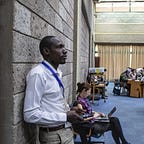Plastic pollution is accelerating climate change for the worse.
By Benard Ogembo.
Nearly 2 billion tons of carbon dioxide emissions is from the world’s penchant love for things plastic-made, says a new report from GRID-Arendal called, “Climate impacts of plastics: Global actions to stem climate change and end plastic pollution”.
The report either highlights that plastic make a substantial contribution to annual greenhouse gas emissions throughout their life cycle from sourcing raw materials, production of different products to eventual disposal at end of use.
The exhaustible report gives suggestions on what needs to be addressed in the new international treaty to tackle the challenges of plastic in connection with climate change.
Between 3.8 and 4.5 percent of global greenhouse gas emissions are emitted throughout the entire life cycle of plastics. This is projected to grow as production of plastic continues to grow.
According to policymakers, in order to achieve the most significant impact in reducing greenhouse gas emissions, the most time and energy should be dedicated to minimising investments in plastic production.
“Plastic pollution is making climate change worse. We must be aware of the linkages between plastics and the triple planetary crisis, to search for solutions and minimise harmful impacts on the environment and people. Plastic action is climate action,” says Ieva Rucevska, senior expert on plastic and one of the authors on the new report.
This comes at a time when over 5,000 world delegates from 193member countries, including heads of states and ministers congregated in Nairobi, Kenya for the sixth United Nations Environment Assembly (UNEA-6) to address climate change, biodiversity loss and pollution.
The UNEA 6 is a political platform bringing together environment ministers to set priorities for the global environmental agenda. It is the planet’s top decision-making body on the environment.
In her opening remarks, Inger Anderson, the executive director of the United Nations Environment Programme (UNEP) rallied the delegates to focus on measures that promote climate justice, enhance air and water quality, and strengthen ocean governance.
Karen Landmark, managing director at GRID-Arendal, a non-profit environmental communications centre based in Norway, noted that for a long time, the focus on plastic has been that it is a pollution problem.
She says, “We highlight, in this report, another problematic aspect of plastic that is, its impact on climate change, which largely stems from the production of plastic and plastic products. We believe it is essential to bring these findings to the attention of policymakers, making sure the international efforts are aimed at addressing this plastic menace. Our analysis also noted the gaps in plastic-related greenhouse gas emissions and underscores the need to sufficiently highlight and address them.”
In 2015, the sourcing, production, use and disposal of plastics collectively contributed to greenhouse gas emissions ranging from 1.8 Gt to 2 Gt of CO2e, accounting for approximately 3.8 percent to 4.5 percent of global greenhouse gas emissions.
A publication by the Plastics Europe found that despite the ongoing efforts to reduce plastic consumption and improve recycling, global plastic production increased from 322 million tonnes in 2015 to 400 million tonnes (excluding polymers not converted to plastic parts) in 2022.
According to International Energy Agency (IEA), plastics have become one of the fastest growing materials in the global economy, surpassing the growth rates of commodities such as steel, aluminium, and cement.
The findings of the report which were discussed during an event at the UNEA 6 on Friday are supported by a review of country and group submissions to INC-3. A total of 125 countries provided inputs related to climate change, indicating the inclusion of greenhouse gas emissions as a plastic pollutant under the new global plastic instrument, and for the plastic instrument to strengthen action against climate change.
This report also points out that the absence of internationally agreed definitions and harmonised terminology in research and national reporting presents a significant challenge in understanding and communicating intervention points for addressing the climate impacts of plastics.
The clear definitions for the life cycle stages and associated measures are needed to help generate a common understanding of the problem, its broader linkages to climate change and necessary interventions to address them.
The authors of the report recommend that the new plastic treaty should acknowledge the need for protection of the climate system, alongside its role in safeguarding human health and the environment.
According to Miss Landmark, “It is important to ensure that measures addressing the entire life cycle of plastic are included in the new agreement. The measures we emphasise are aimed at limiting the climate impact of plastic, and what we observe is that the most crucial aspect is reduction, both in the production of plastic and consumption.”
The week-long (5-day) assembly tackled a range of pressing environmental issues through 19 draft resolutions and two draft decisions currently on the table.
The world’s most powerful UN environmental decision-making comes at a time when the world faces a “triple planetary crisis” of climate change, biodiversity loss, and pollution and waste. Ms Landmark urged decision makers to consider the impacts of plastic pollution and linking it with climate change and biodiversity loss.
Backed by strong science, political resolve and engagement with society, UNEA-6 was an opportunity for world governments, civil society groups, the scientific community, and the private sector to shape the global environmental policy for the future.
However, as the meeting ended, some policymakers and civil society groups, such as Greenpeace were left frustrated as they felt that there was once again lack of ambitions reminiscence of what was witnessed during INC-3, as a few countries attempted to water down the ambitious plan to end plastic pollution by 2040.
This year’s assembly boasted a record number of attendees, including heads of state, ministers, and over 5,000 representatives from governments, civil society, and the private sector. The summit also featured the voices of the younger generation, who issued a strong declaration at the Youth Environment Assembly just a week ago before the conference.
Ends
